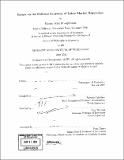| dc.contributor.advisor | Ricardo Caballero and Ivan Werning. | en_US |
| dc.contributor.author | Bruegemann, Bjoren Axel, 1974- | en_US |
| dc.contributor.other | Massachusetts Institute of Technology. Dept. of Economics. | en_US |
| dc.date.accessioned | 2005-09-26T20:03:05Z | |
| dc.date.available | 2005-09-26T20:03:05Z | |
| dc.date.copyright | 2004 | en_US |
| dc.date.issued | 2004 | en_US |
| dc.identifier.uri | http://hdl.handle.net/1721.1/28364 | |
| dc.description | Thesis (Ph. D.)--Massachusetts Institute of Technology, Dept. of Economics, 2004. | en_US |
| dc.description | Includes bibliographical references (p. 122-126). | en_US |
| dc.description.abstract | The stringency of employment protection regulations varies substantially across countries. This thesis studies three mechanisms that can help explain the extent and persistence of this variation. The first chapter explores the ability of employment protection to generate its own political support. Using a version of the Mortensen-Pissarides model, I show that the presence or absence of this ability depends crucially on the features of wage determination. Under the standard assumption of continuous time Nash bargaining, workers value employment protection because it strengthens their hand in bargaining. Workers in high productivity matches benefit most. Yet employment protection shifts the distribution of match-specific productivity toward lower values and thus away from the supporters of regulation. Bilaterally inefficient separations are a feature of wage setting that can partially reverse this negative result. Now workers value employment protection because it delays involuntary dismissals. Workers in low productivity matches gain most since they face the highest risk of layoff. The shift of the productivity distribution toward lower values then becomes a shift toward supporters of employment protection. The second chapter puts forward a simple Ricardian argument suggesting that trade integration can sustain diversity in employment protection regulations. Trade integration enables a rigid country to specialize in activities less dependent on flexibility, mitigating the cost of rigidity. Conversely, it makes a flexible country less willing to become rigid, since doing so means forgoing the gains from trade induced by diverse regulation. | en_US |
| dc.description.abstract | (cont.) This argument is evaluated in a dynamic model of labor turnover and employment protection. The third chapter presents an argument according to which employment protection is a policy that is difficult to introduce. If a country decides to introduce employment protection, it is reasonable to assume that firms can adjust employment levels before protection is actually implemented. Firms then have an incentive to dismiss some workers today in order to avoid high employment protection in the future. Anticipating this, these workers may oppose the introduction of employment protection. Delayed implementation can give rise to situations in which both low and high employment protection are stable political outcomes. | en_US |
| dc.description.statementofresponsibility | by Bjoren Axel Bruegemann. | en_US |
| dc.format.extent | 126 p. | en_US |
| dc.format.extent | 5588736 bytes | |
| dc.format.extent | 5588536 bytes | |
| dc.format.mimetype | application/pdf | |
| dc.format.mimetype | application/pdf | |
| dc.language.iso | en_US | |
| dc.publisher | Massachusetts Institute of Technology | en_US |
| dc.rights | M.I.T. theses are protected by copyright. They may be viewed from this source for any purpose, but reproduction or distribution in any format is prohibited without written permission. See provided URL for inquiries about permission. | en_US |
| dc.rights.uri | http://dspace.mit.edu/handle/1721.1/7582 | |
| dc.subject | Economics. | en_US |
| dc.title | Essays on the political economy of labor market regulation | en_US |
| dc.type | Thesis | en_US |
| dc.description.degree | Ph.D. | en_US |
| dc.contributor.department | Massachusetts Institute of Technology. Department of Economics | |
| dc.identifier.oclc | 56191122 | en_US |
